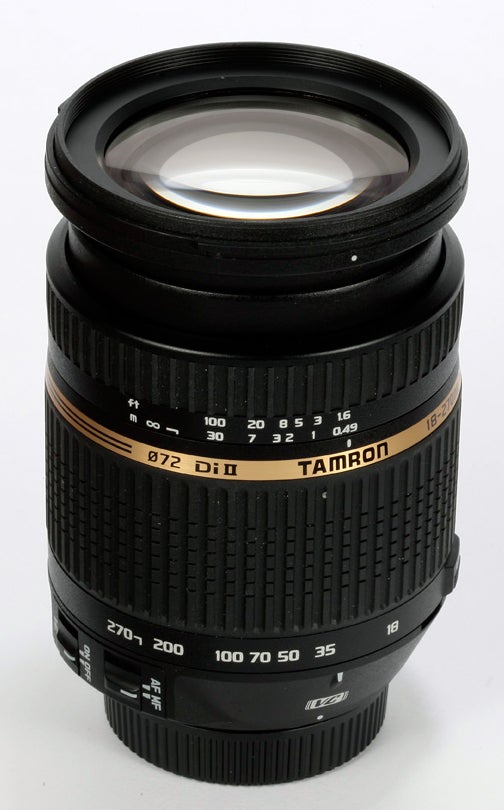Tamron 18-270mm f/3.5-6.3 DI-II (IF) LD VC Macro Aspherical Review
Tamron 18-270mm f/3.5-6.3 DI-II (IF) LD VC Macro Aspherical Review
How far does the the flagship Tamron 18-270mm f/3.5-6.3 DI-II (IF) LD VC Macro Aspherical lens build on the promise of the earlier 18-250mm model, and does it make the extra £100 a worthwhile investment?

Verdict
Pros
- Useful Vibration Compensation
Cons
- MTF at loong focal lengths
Key Specifications
- Review Price: £450
It may only offer 20mm more of maximum focal length, but Tamron’s 18-270mm zoom is much more capable than its 18-250mm sibling. The biggest difference is, in fact, the addition of a Vibration Compensation system that vastly improves usability.
The 18-270mm lens is longer, wider, heavier, more expensive and features more elements. These are not, however, necessarily bad things: the wider barrel is easier to grip and its greater length means the zoom ring has almost the same wideness as the zoom and focus rings combined on the older lens. The zoom action has a slight hesitation around 70-100mm, but this is minor and does not detract from its overall smoothness.
The Vibration Compensation system, which takes a moment to activate, does an excellent job of steadying the viewfinder image and is probably the best reason to prefer this lens over the 250mm version. Sadly, the higher-technology lens is available in Canon and Nikon fits only, whereas its ancestor is also available in Pentax and Sony mounts.
As was the case for the 250mm version, the MTF curves again show a distinct separation between the longer and shorter focal lengths. The differences are not quite as acute due to both some improvement at the longer focal-lengths and a little mid-range degradation. That said, there is a significant improvement in wide-aperture performance generally and the minimum focal-length MTF curve is much better than before. Nevertheless, there is no escaping the fact that Tamron still has some work to do in respect of the longer focal lengths’ MTF figures.
Chromatic aberration was seen, especially at the maximum focal length, in both the technical images and also demanding real-world pictures, such as along the edges of the distant blocks of flats in the standard test scene. Ironically, it was probably the greater sharpness provided by the activated vibration compensation system that allowed the fringes to be seen in all their glory.

Sample images




Verdict
Pedigrees don’t get much better than the Tamron 18-270mm f/3.5-6.3 Di II VC LD Aspherical (IF) Macro lens. This 18-270mm’s immediate ancestor was named EISA Consumer Lens of the Year Award 2007-8 and its more-modest predecessor won TIPA’s Best Consumer Lens of the Year Award in 2005.All of this excitement is understandable given that Tamron’s design boasts the kind of zoom range that is normally offered only by compact-camera lenses. The latest version has a full 15x zoom range and also features Vibration Control (VC) technology as well as the usual range of special-dispersion glasses and aspheric profiles. All with a list price of £600 but available from some WDC advertisers for around £475.The Tamron 18-270mm f/3.5-6.3 Di II VC LD Aspherical (IF) Macro lens has a sleek cylindrical profile with a generous zoom ring and a rather narrow manual-focusing ring, which rotates in AF mode despite the presence of an internal focusing system. Zooming is slightly stiff at mid-range focal lengths (around 150mm) and the total extension almost doubles the length of the barrel but the lens is easy to use and its balance remains good throughout.Inevitably, given its compact dimensions, the maximum aperture is somewhat limited. This limits creative picture-taking, in terms of restricting depth-of-field, but at least the VC system allows longer exposures to be used, thereby increasing usability in a different direction.Technical testing reveals a split personality: at shorter focal lengths this is a well-behaved lens that would give many more-modest zooms a run for their money, whereas at longer focal lengths its resolution becomes much less impressive due to high-magnification softness and some chromatic aberration. Barrel distortion is visible at the 18mm setting but this quickly disappears and there is only slight pincushion distortion from about 35mm right out to 270mm.Despite these clinical findings, real-world pictures taken at what ought to be ‘weak’ focal length settings exhibit no obvious flaws, which is very encouraging. As in so many modern lenses, the ‘macro’ label is cheeky although this lens does have the noteworthy ability to cover an object-field area of just under 50x70mm.Overall this is an impressive lens. Other lenses may be better honed for specific situations but I can well imagine being very satisfied with Tamron’s superzoom if it were the sole lens taken on a speculative outing or away on holiday.
Trusted Score
Score in detail
-
Value 9
-
Design 9
-
Image Quality 9
-
Features 10

